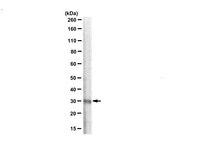ABS2088 Sigma-AldrichAnti-CLIC4
Detect Chloride intracellular channel protein 4 using this rabbit polyclonal Anti-CLIC4, Cat. No. ABS2088, used in Western Blotting and Immunofluorescence, Western Blotting, Immunohistochemistry (Paraffin) and Immunoprecipitation.
More>> Detect Chloride intracellular channel protein 4 using this rabbit polyclonal Anti-CLIC4, Cat. No. ABS2088, used in Western Blotting and Immunofluorescence, Western Blotting, Immunohistochemistry (Paraffin) and Immunoprecipitation. Less<<Recommended Products
Overview
| Replacement Information |
|---|
Key Specifications Table
| Species Reactivity | Key Applications | Host | Format | Antibody Type |
|---|---|---|---|---|
| R | WB, IF, IH(P), IP | Rb | Purified | Polyclonal Antibody |
| References |
|---|
| Product Information | |
|---|---|
| Format | Purified |
| Presentation | Purified rabbit polyclonal antibody in buffer containing 0.1 M Tris-Glycine (pH 7.4), 150 mM NaCl with 0.02% sodium azide. |
| Quality Level | MQ100 |
| Physicochemical Information |
|---|
| Dimensions |
|---|
| Materials Information |
|---|
| Toxicological Information |
|---|
| Safety Information according to GHS |
|---|
| Safety Information |
|---|
| Storage and Shipping Information | |
|---|---|
| Storage Conditions | Stable for 1 year at 2-8°C from date of receipt. |
| Packaging Information | |
|---|---|
| Material Size | 100 µL |
| Transport Information |
|---|
| Supplemental Information |
|---|
| Specifications |
|---|
| Global Trade Item Number | |
|---|---|
| Catalog Number | GTIN |
| ABS2088 | 04054839168734 |
Documentation
Anti-CLIC4 Certificates of Analysis
| Title | Lot Number |
|---|---|
| Anti-CLIC4 -Q2814924 | Q2814924 |











